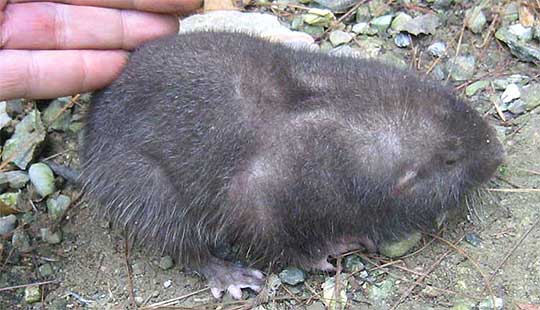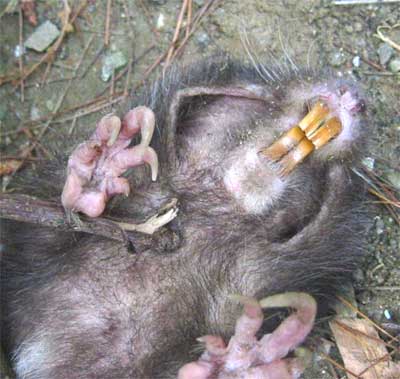Excerpts from Jim Conrad's
Naturalist Newsletter
from the January 28, 2008 issued from Yerba Buena Clinic just outside Pueblo Nuevo Solistahuacan, Chiapas, MÉXICO
about 1740 meters in elevation, ± LAT. 17° 11' 27"N, LONG. -92° 53' 35"W
POCKET GOPHER
Both the most exciting and most frustrating event of last week occurred Saturday morning when the firewood wardens brought me a critter they'd just found in one of the invaders' cornfields. The animal's top view is shown below:

The much more interesting bottom view is shown below.

Look at those cheek pouches! Obviously it's a rodent. I'm guessing that it's a pocket gopher, though I have no experience with such animals. What's frustrating is that here I not only have no browsing access to the Internet, but also no field guides to remind me of the differences between plain gophers and pocket gophers, and what other closely related mammals exist. If you have a mammal field guide and possibly access to literature telling what gopher-type rodents are found down here, I'd love to hear from you.
The fellows spotted the critter hurrying across the ground but upon their approach it stopped and hunkered up, apparently "playing possum" by feigning death and thus maybe causing enemies to lose interest. When the wardens flipped over the animal green, compacted balls of clipped-off leaves fell from the cheek pouches.
For any mammalogist out there needing exact measurements for an identification, in the first picture the length of the finger next to my small finger, from crease with the palm to the tip, is exactly 77 mm, or 3.03 inches. The tail was very short, about 2.5 cm, or an inch. Note the grooved incisors. I'm very interested in knowing if this is another disjunct, ice-age relict, like our Sweetgums and Black Tupelos.
from the February 11, 2008 issued from Yerba Buena Clinic just outside Pueblo Nuevo Solistahuacan, Chiapas, MÉXICO
about 1740 meters in elevation, ± LAT. 17° 11' 27"N, LONG. -92° 53' 35"W
POCKET GOPHER FEEDBACK
I was tickled with all the feedback I got about the January 28 Newsletter's picture of a pocket gopher.
John in California's central Sierras said that pocket gophers are the favorite food of his cats, and he quoted an authority saying that pocket gophers "act like little rototillers, loosening and aerating the soil."
Jarvis, a zoology prof in North Carolina, writes, "There are numerous species of them in Mexico and I don't feel up to the task of identifying it to species, but it sure looks like the family Geomyidae."
Casey somewhere in Cyberspace wrote "There's three genera in NA. From what I can tell from the photo it's Pappogeomys -- one groove on the incisor as opposed to none (Thomomys) or two (Geomys).
John in New York worked with a search engine using the keywords "Mexican pocket gophers" and finally decided that "specifically MEXICAN pocket gophers get named Pappogeomys castanops." John also says that his daughter in Colorado can't grow a garden without losing most of it to pocket gophers.
Finally, Bea in Ontario actually sent a description and illustration of John's Pappogeomys castanops from her Peterson Field Guide. Peterson calls the species the Mexican Pocket Gopher and states that the species "may be distinguished from other pocket gophers by the distinct single groove down middle (front) of each upper incisor."
Therefore, thanks to all the above mails, which arrived in my INBOX in the order presented here, the final identity was gradually revealed as in a Sherlock Holms mystery, ending with Bea's picture. I'll bet my pocket gopher really is the Mexican Pocket Gopher, or a very closely related species, probably of the genus Pappogeomys, if such exists.